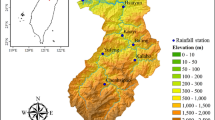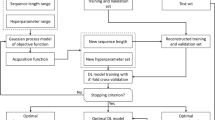Abstract
Reliable and accurate prediction models effectively deal with nonlinear and non-stationary characteristics of reservoir inflow and associated variables. Therefore, a Hybrid Deep Learning Inflow Prediction-Rolling Window (HDeepLIP-RW) framework is proposed in this study for efficient inflow prediction. The HDeepLIP-RW framework utilizes hybrid alternatives of four different RNN architectures bidirectional long short-term memory (BiLSTM), gated recurrent unit (GRU), long short-term memory (LSTM), and simple RNN (sRNN) by employing RW technique. Firstly, the conventional split data (CSD) technique is applied to divide the multivariate hydro-meteorological data of Ermenek Dam, Turkey, into training, validation, and testing periods. Afterward, the processed data is employed as input by standalone and hybrid models for inflow prediction. Thirdly, the RW technique is used to divide the data to train and validate the model. Finally, different standalone and HDeepLIP-RW prediction models utilizing the RW technique are also developed to compare the performance of the proposed model with counterparts. The prediction results in terms of statistical metrics and different plots manifest the applicability of models utilizing RW for inflow prediction in contrast to the CSD-built models. Furthermore, the HDeepLIP-RW based BiLSTM-GRU model outperforms all the counterpart models by demonstrating the highest performance and accuracy. The RW-based BiLSTM-GRU model reduces RMSE contrast to the CSD-based best performing by 0.300 for GRU-LSTM during the testing period. Likewise, the prediction accuracy according to NS was increased by 23.37% compared to standalone models and 19.26% according to hybrid methods by splitting the data with the RW method. The overall results are enlightening and substantiate the viability of the BiLSTM-GRU model utilizing the HDeepLIP-RW framework for inflow prediction with an equal opportunity for similar applications.













Similar content being viewed by others
Data availability
Data are available on request due to privacy or other restrictions.
Code availability
The source code of the proposed methods can be found at https://github.com/Hapaydin/Rolling-Window.
References
Akpınar H (2000) Knowledge discovery and data mining in databases. Istanb Univ J Fac Bus 29(1):1–22
Atalay I (2010) Applied climatology. Meta Publishing, Izmir
Allawi MF, Hussain IR, Salman MI et al (2021) Monthly inflow forecasting utilizing advanced artificial intelligence methods: a case study of Haditha Dam in Iraq. Stoch Environ Res Risk Assess. https://doi.org/10.1007/s00477-021-02052-7
Aparna S, Vishwa A (2018) Long short term memory and rolling window technique for modeling power demand prediction. In: Proceedings of the second international conference on intelligent computing and control systems (ICICCS 2018), IEEE Xplore Compliant Part Number: CFP18K74-ART; ISBN: 978-1-5386-2842-3
Baker SA, Rajagopalan B, Wood AW (2021) Enhancing ensemble seasonal streamflow forecasts in the Upper Colorado River Basin using multi-model climate forecasts. JAWRA J Am Water Resour Assoc 57(6):906–922. https://doi.org/10.1111/1752-1688.12960
Besaw LE, Rizzo DM, Bierman PR, Hackett WR (2010) Advances in ungauged streamflow prediction using artificial neural networks. J Hydrol 386:27–37. https://doi.org/10.1016/j.jhydrol.2010.02.037
Bhattacharya B, Solomatine DP (2000) Application of artificial neural network in stage-discharge relationships. In: 4th Int. conference on hydroinformatics, Iowa City, USA, 1–7, July 23–27, 2000
Bosmans JHC, van Beek LPH, Sutanudjaja EH, Bierkens MFP (2017) Hydrological impacts of global land cover change and human water use. Hydrol Earth Syst Sci 21:5603–5626. https://doi.org/10.5194/hess-21-5603-2017
Campos LCD, Fonseca LGF, Fonseca TL, de Abreu GD, Pires LF, Gorodetskaya Y (2019) Short-term streamflow forecasting for Para´ıba do Sul River using deep learning. In: Oliveira PM, Novais P, Reis LP (eds) Progress in artificial intelligence: 19th EPIA Conference on artificial intelligence, EPIA 2019. Vila Real, Portugal, September 3–6, 2019
Chang FJ, Chen YC (2001) A counter propagation fuzzy-neural network modeling approach to real time streamflow prediction. J Hydrol 245:153–164. https://doi.org/10.1016/S0022-1694(01)00350-X
Chiew FHS, Stewardson MJ, McMahon TA (1993) Comparison of six rainfall-runoff modelling approaches. J Hydrol 147:1–36. https://doi.org/10.1016/0022-1694(93)90073-I
Choong S-M, El-Shafie A (2015) State-of-the-art for modelling reservoir inflows and management optimization. Water Resour Manag 29(4):1267–1282. https://doi.org/10.1007/s11269-014-0872-z
Chugh A (2020) Retrieved from: https://www.geeksforgeeks.org/deep-learning-introduction-to-long-short-term-memory/
Coulibaly P, Haché M, Fortin V, Bobée B (2005) Improving daily reservoir inflow forecasts with model combination. J Hydrol Eng 10:91–99. https://doi.org/10.1061/(ASCE)1084-0699(2005)10:2(91)
Curebal I, Efe R (2014) An overview of climatic features of the Ermenek River Basin. Procedia Soc Behav Sci 120:609–620. https://doi.org/10.1016/j.sbspro.2014.02.141
de Lavenne A, Thirel G, Andréassian V, Perrin C, Ramos M-H (2016) Spatial variability of the parameters of a semi-distributed hydrological model, In: Proc. IAHS, vol 373, pp 87–94. https://doi.org/10.5194/piahs-373-87-2016
Dion P, Martel J-L, Arsenault R (2021) Hydrological ensemble forecasting using a multi-model framework. J Hydrol 600:126537. https://doi.org/10.1016/j.jhydrol.2021.126537
Efe R (1998) Ermenek River Basin: natural environment characteristics. Cantay Bookstore, Istanbul
Ermenek (2020) http://www.ermenek.gov.tr/ermenek-baraji. Accessed 18 Dec 2020
Ermenek (2021) http://ermenek.bel.tr/icerik/ermenek-cografi-konumu. Accessed 16 June 2021
Ermenek (2022) https://tr.climate-data.org/asya/tuerkiye/karaman/ermenek-18657/. Accessed 10 Jan 2022
Gronewold AD, Smith JP, Read LK, Crooks JL (2020) Reconciling the water balance of large lake systems. Adv Water Resour 137:103505. https://doi.org/10.1016/j.advwatres.2020.103505
Hallouin T, Bruen M, O’Loughlin FE (2020) Calibration of hydrological models for ecologically relevant streamflow predictions: a trade-off between fitting well to data and estimating consistent parameter sets? Hydrol Earth Syst Sci 24:1031–1054. https://doi.org/10.5194/hess-24-1031-2020
Hand DJ (1998) Data mining: statistics and more? Am Stat 52:112–118. https://doi.org/10.1080/00031305.1998.10480549
Huang Z, Xu W, Yu K (2015) Bidirectional LSTM-CRF models for sequence tagging
Huang IH, Chang MJ, Lin GF (2021) An optimal integration of multiple machine learning techniques to real-time reservoir inflow forecasting. Stoch Environ Res Risk Assess. https://doi.org/10.1007/s00477-021-02085-y
Ibañez SC, Dajac CVG, Liponhay MP, Legara EFT, Esteban JMH, Monterola CP (2021) Forecasting reservoir water levels using deep neural networks: a case study of Angat Dam in the Philippines. Water 14(1):34. https://doi.org/10.3390/w14010034
Idrees MB, Jehanzaib M, Kim D et al (2021) Comprehensive evaluation of machine learning models for suspended sediment load inflow prediction in a reservoir. Stoch Environ Res Risk Assess 35:1805–1823. https://doi.org/10.1007/s00477-021-01982-6
Jacobs P (1999) Data mining: what general managers need to know. Harv Manag Update 4(10):8
Joseph B (1996) Data mining with neural networks: solving business problems from application development to decision support. McGraw Hill Text
Jothiprakash V, Kote AS (2011) Improving the performance of data-driven techniques through data pre-processing for modelling daily reservoir inflow. Hydrol Sci J 56(1):168–186. https://doi.org/10.1080/02626667.2010.546358
Kasik G, Ozturk C, Dogan HH (2000) Macrofungi of Ermenek (Karaman) Region. S.Ü. Fac Arts Sci J Sci Res 1: 61–65. Konya
Karunanithi N, Grenney WJ, Whitley D, Bovee K (1994) Neural networks for river flow prediction. J Comput Civ Eng 8:201–220. https://doi.org/10.1061/(ASCE)0887-3801(1994)8:2(201)
Kim T, Shin J-Y, Kim H, Kim S, Heo J-H (2019) The use of large-scale climate indices in monthly reservoir inflow forecasting and its application on time series and artificial intelligence models. Water 11(2):374. https://doi.org/10.3390/w11020374
Kishore S, Ganesh Swaroop V, Prasad BS (2020) Reservoir inflow prediction using multi-model ensemble system. In: 2020 International conference on communication, computing and industry 4.0 (C2I4). 2020 International conference on communication, computing and industry 4.0 (C2I4). IEEE. https://doi.org/10.1109/c2i451079.2020.9368942
Kombo OH, Kumaran S, Sheikh YH, Bovim A, Jayavel K (2020) Long-term groundwater level prediction model based on hybrid KNN-RF technique. Hydrology 7:59. https://doi.org/10.3390/hydrology7030059
Kratzert F, Klotz D, Brenner C, Schulz K, Herrnegger M (2018) Rainfall–runo modelling using Long Short-Term Memory (LSTM) networks. Hydrol. Earth Syst Sci 22:6005–6022. https://doi.org/10.5194/hess-22-6005-2018
Latif SD, Ahmed AN, Sathiamurthy E, Huang YF, El-shafie A (2021) Evaluation of deep learning algorithm for inflow forecasting: a case study of Durian Tunggal Reservoir, Peninsular Malaysia. Nat Hazards 109:351–69. https://doi.org/10.1007/s11069-021-04839-x
Li L, Noorian F, Moss DJM, Leong PHW (2014) Rolling window time series prediction using MapReduce. In: Proceedings of the 2014 IEEE 15th international conference on information reuse and integration (IEEE IRI 2014), 2014, pp 757–764. https://doi.org/10.1109/IRI.2014.7051965.
Li Y, Liang Z, Hu Y, Li B, Xu B, Wang D (2020) A multi-model integration method for monthly streamflow prediction: modified stacking ensemble strategy. J Hydroinformatics 22(2):310–326. https://doi.org/10.2166/hydro.2019.066
Nguyen M (2018) https://towardsdatascience.com/illustrated-guide-to-lstms-and-gru-s-a-step-by-step-explanation-44e9eb85bf21
Nagesh Kumar D, Srinivasa Raju K, Sathish T (2004) River flow forecasting using recurrent neural networks. Water Resour Manag 18:143–161. https://doi.org/10.1023/B:WARM.0000024727.94701.12
Nayak P, Sudheer K, Rangan D, Ramasastri K (2004) A neuro-fuzzy computing technique for modeling hydrological time series. J Hydrol 291:52–66. https://doi.org/10.1016/j.jhydrol.2003.12.010
Okkan U, Serbes ZA (2013) The combined use of wavelet transform and black box models in reservoir inflow modelling. J Hydrol Hydromech 61(2):112–119. https://doi.org/10.2478/johh-2013-0015
Quiñones-Grueiro M, Prieto-Moreno A, Verde C, Llanes-Santiago O (2019) Data-driven monitoring of multimode continuous processes: a review. Chemom Intell Lab Syst 189:56–71. https://doi.org/10.1016/j.chemolab.2019.03.012
Savas S, Topaloglu N, Yilmaz M (2012) Data mining and practices in Turkey. Istanb Commer Univ J Sci 11(21):1–23
Schuster M, Paliwal K (1997) Bidirectional recurrent neural networks. IEEE Trans Signal Process 45(11):2673–2681. https://doi.org/10.1109/78.650093
Sibtain M, Li X, Saleem S (2020) A multivariate and multistage medium-and long-term streamflow prediction based on an ensemble of signal decomposition techniques with a deep learning network. Adv Meteorol 2020:8828664. https://doi.org/10.1155/2020/8828664
Singh N (2016) Climate change and human right to water: problems and prospects. In: The human right to water. Springer, Cham, pp 83–103. https://doi.org/10.1007/978-3-319-40286-4_5
Sivakumar B, Jayawardena AW, Fernando TMKG (2002) River flow forecasting: use of phase-space reconstruction and artificial neural networks approaches. J Hydrol 265:225–245. https://doi.org/10.1016/S0022-1694(02)00112-9
Swanson NR, White H (1997) Forecasting economic time series using flexible versus fixed specification and linearversus nonlinear econometric models. Int J Forecast 13(4):439–461. https://doi.org/10.1016/S0169-2070(97)00030-7
SWW (2019) http://dsi.gov.tr/haberler/2014/11/21/ermenek-baraj%C4%B1-ve-hes-in-kesin-kabul%C3%BC-yap%C4%B1ld%C4%B1-. Accessed 3 Nov 2019
Sudheer KP, Jain SK (2003) Radial basis function neural network for modeling rating curves. J Hydrol Eng 8:161–164. https://doi.org/10.1061/(ASCE)1084-0699(2003)8:3(161)
Tan M, Yolcu H (2021) Current status of forage crops cultivation and strategies for the future in Turkey: a review. J Agric Sci 27(2):114–121. https://doi.org/10.15832/ankutbd.903732
Tian D, He X, Srivastava P et al (2021) A hybrid framework for forecasting monthly reservoir inflow based on machine learning techniques with dynamic climate forecasts, satellite-based data, and climate phenomenon information. Stoch Environ Res Risk Assess. https://doi.org/10.1007/s00477-021-02023-y
Thuarisingham BM (2003) Web data mining and applications in business intelligence and counter terrorism. CRC Press LLC, Boca Raton
Troin M, Arsenault R, Wood AW, Brissette F, Martel J-L (2021) Generating ensemble streamflow forecasts: A review of methods and approaches over the past 40 years. Water Resources Research 57(7):e2020WR028392. https://doi.org/10.1029/2020WR028392
Wegayehu EB, Muluneh FB (2021) Multivariate streamflow simulation using hybrid deep learning models. Comput Intell Neurosci. https://doi.org/10.1155/2021/5172658
WHO (2006) Guidelines for drinking-water quality. World Health Organization, Geneva
Yamaç SS (2021) Reference evapotranspiration estimation With kNN and ANN Models using different climate input combinations in the semi-arid environment. J Agric Sci 27(2):129–137. https://doi.org/10.15832/ankutbd.630303
Yang T, Asanjan AA, Welles E, Gao X, Sorooshian S, Liu X (2017) Developing reservoir monthly inflow forecasts using artificial intelligence and climate phenomenon information. Water Resour Res 53(4):2786–2812
Yaseen ZM, El-Shafie A, Jaafar O, Afan HA, Sayl KN (2015) Artificial intelligence based models for stream-flow forecasting: 2000–2015. J Hydrol 530:829–844
Yu Y, Si X, Hu C, Zhang J (2019) A review of recurrent neural networks: LSTM cells and network architectures. Neural Comput 31(7):1235–1270. https://doi.org/10.1162/neco_a_01199
Zealand CM, Burn DH, Simonovic SP (1999) Short term streamflow forecasting using artificial neural networks. J Hydrol 214:32–48. https://doi.org/10.1016/S0022-1694(98)00242-X
Zhang D, Lin J, Peng Q, Wang D, Yang T, Sorooshian S, Liu X, Zhuang J (2018) Modeling and simulating of reservoir operation using the artificial neural network, support vector regression, deep learning algorithm. J Hydrol 565:720–736. https://doi.org/10.1016/j.jhydrol.2018.08.050
Zhang JS, Xiao XC (2000) Predicting chaotic time series using recurrent neural network. Chin Phys Lett 17(2):88
Zhang W, Wang H, Lin Y, Jin J, Liu W, An X (2021) Reservoir inflow predicting model based on machine learning algorithm via multi-model fusion: a case study of Jinshuitan river basin. IET Cyber-Syst Robotics 3(3):265–277. https://doi.org/10.1049/csy2.12015
Funding
No funding was received.
Author information
Authors and Affiliations
Ethics declarations
Conflict of interest
The authors declare no conflict of interest.
Additional information
Publisher's Note
Springer Nature remains neutral with regard to jurisdictional claims in published maps and institutional affiliations.
Rights and permissions
About this article
Cite this article
Feizi, H., Apaydin, H., Sattari, M.T. et al. Improving reservoir inflow prediction via rolling window and deep learning-based multi-model approach: case study from Ermenek Dam, Turkey. Stoch Environ Res Risk Assess 36, 3149–3169 (2022). https://doi.org/10.1007/s00477-022-02185-3
Accepted:
Published:
Issue Date:
DOI: https://doi.org/10.1007/s00477-022-02185-3




